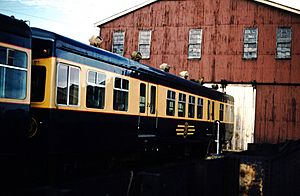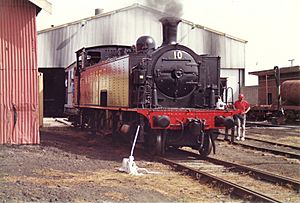South Maitland Railway Workshops facts for kids
Quick facts for kids South Maitland Railway Workshops |
|
|---|---|

SMR Rail Car No 2 outside workshops, 1961
|
|
| Location | Junction Street, Telarah, City of Maitland, New South Wales, Australia |
| Official name: South Maitland Railway Workshops | |
| Type | state heritage (complex / group) |
| Designated | 2 April 1999 |
| Reference no. | 627 |
| Type | Railway Workshop |
| Category | Transport - Rail |
| Lua error in Module:Location_map at line 420: attempt to index field 'wikibase' (a nil value). | |
The South Maitland Railway Workshops are a special historical site in Telarah, New South Wales, Australia. This place used to be a busy workshop where trains were fixed. Today, it's partly a museum and partly still used for industrial work. It was officially recognized as an important heritage site on April 2, 1999.
Contents
History of the Workshops
Early Land Use
The land where the workshops stand was first given to Thomas Winder in 1842. Later, in 1884, Albert Simpson bought it. Around the 1840s, people started looking for coal near Newcastle.
Coal mining became a big deal in the Maitland area. Commercial mining began at Greta Coalfield in the 1860s. Then, mines opened at East Greta in 1869 and another one there in 1898. More mines soon followed in the area.
Building the East Greta Colliery Railway
The East Greta Coal Mining Company started in 1891. One of their first big projects was to build a railway line. This line connected the East Greta No. 1 Colliery to the main government railway, called the Great Northern Railway.
The railway line opened in 1893. At first, the New South Wales Government Railways ran the trains on it. In 1896, the East Greta Coal Mining Company took over running the trains. They built their own sidings, which are extra tracks for trains to wait or store wagons.
More sidings were added over time as the railway grew. By 1910, even more storage tracks were needed. These new tracks were called Mt Dee sidings. They were used to store full coal wagons, while the older sidings held empty ones.
Expanding the Railway Network
In 1901, a new branch line opened. It went from East Greta No.1 Colliery to Stanford Merthyr Colliery. Then, in 1904, a line to Cessnock was built. This line branched off the Stanford Merthyr line.
These railway lines carried coal, goods, and even passengers. People from the mining towns could travel to Maitland. Passenger services started in 1902. At first, people had to find their own way from the junction to West Maitland. But in 1903, the train service was extended all the way to West Maitland.
The South Maitland Railway stopped running passenger trains in 1967. The New South Wales Government Railways stopped using the line for trains in 1972.
Creating the Railway Workshops
Building the workshops began around 1904. The East Greta Coal Mining Company built a place to store and fix locomotives. This first building was a two-track engine shed. In 1912, a bigger, four-track shed made of wood and iron replaced it. This shed was later taken down in 1981 to build a modern steel shed.
The main workshop building we see today was built between 1912 and 1918. By 1918, the site also had a sand drying shed, a cabin for signing on, and a wooden platform for loading coal. A new coal loader with a conveyor belt was added in 1927.
Old goods sheds from Caledonia and Weston Stations were moved here in 1930. They were used as an oil store and a lunch room. A brick bath house was built in 1943. In 1957, a new toilet block, a machine shop, and a stores building were added. The old battery store was removed. In 1981, a new sand house and battery shed were built.
The original Mount Dee homestead on the hill became offices. The first new building was the large Erecting & Repair Workshop. As the railway grew in the 1920s, most of the important buildings were put in place. Brick buildings were added in the 1950s. The last new steel-framed Running Shed was built in 1981.
South Maitland Railways Ltd is Formed
In 1918, two companies, Hebburn Ltd and East Greta Coal Mining Co., joined their railway interests. They formed a new company called South Maitland Railways Ltd. This new company took over the railway lines, locomotives, and all the passenger and goods trains. They also took over the workshops and facilities at East Greta Junction.
Before this, repair work was done at the East Greta Coal Mining Company's general workshops. But after South Maitland Railways was formed, all locomotive and train repair work moved to the East Greta Junction Workshops.
Changes in Ownership and New Uses
In 1931, the East Greta Coal Mining Co. was taken over by another company. This gave them a 50% share of South Maitland Railways. Later, in the 1940s, the company name changed to South Maitland Railways Proprietary Limited.
In 1960, a new company called Coal & Allied Industries Ltd (C&A) was formed. They took over the 50% share in South Maitland Railways. Then, in 1967, Coal & Allied bought Hebburn Ltd. This gave them full control of South Maitland Railways. South Maitland Railways continued as part of Coal & Allied until 1989. Then, a private group bought SMR Pty Ltd.
Full-time work at the workshops by South Maitland Railways staff ended in 1983. This was when steam trains stopped being used on the South Maitland Railway. The workshops were still used a little to maintain the remaining steam locomotives until 1987. That's when the Richmond Vale Railway closed.
In 1989, the Hunter Valley Training Co. bought the site. They cleaned it up and reopened the workshops as a training center for apprentices. By 1990, the site was leased to GEC Alstom Australia P/L. The current complex opened in 1991 and has been used for heavy industry ever since.
In 2015, three workshop buildings were leased to the Maitland Rail Museum. They now use these buildings as part of their museum. There are also talks about the museum leasing a fourth building, which used to be the Blacksmith's Shop.
Why the Workshops are Important
The South Maitland Railway Workshops are very important because:
- They are one of the oldest railway workshops in Australia that kept working for a long time. They show over 70 years of history about how steam railways grew and developed.
- Most of the original buildings and layout are still there. This helps us understand how a steam railway workshop operated.
- They were the biggest private railway workshops in New South Wales. This shows how important coal mining and steam trains were, both locally and for the whole country.
The South Maitland Railway Workshops were officially added to the New South Wales State Heritage Register on April 2, 1999.
Images for kids



